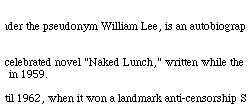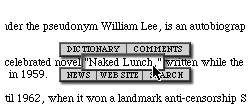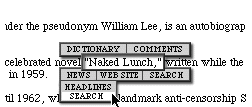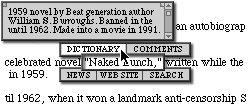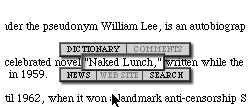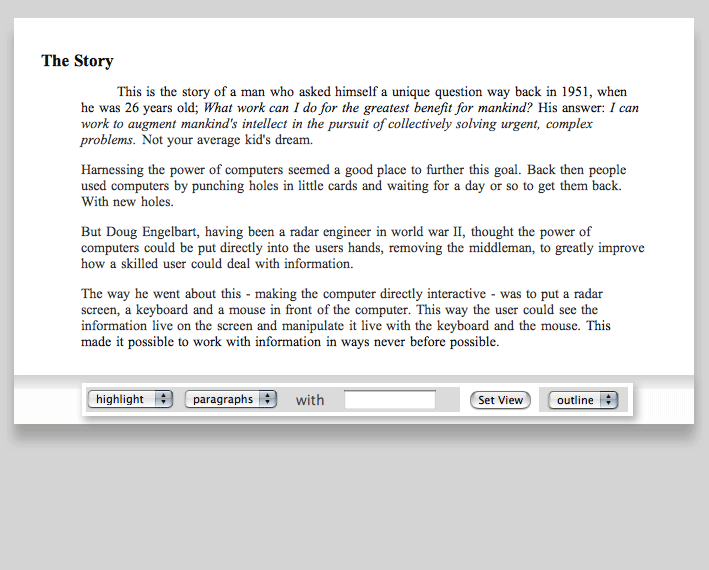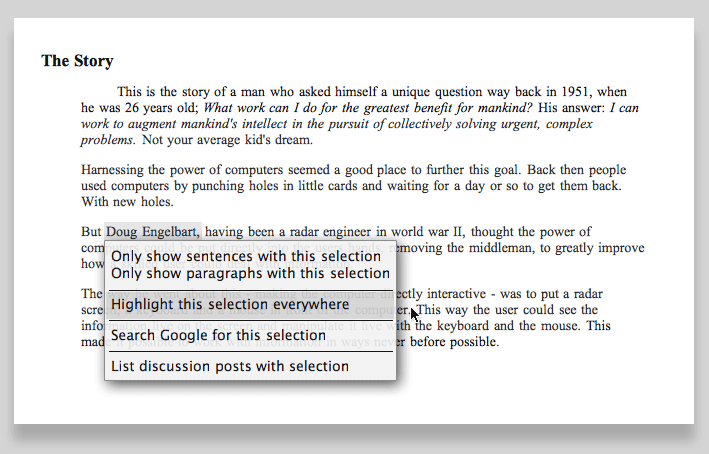Automatic HyperText. comment
HyperText, although having a nice life on the Web, will never realize its full potential as long as the author is required to manually create the HyperText links.
Note this article, from around 1996/97 has led to the http://www.cynapse.org project. I no longer talk about automatic hypertext, Ted showed me how silly that is. It's all about symbol manipulation.
Should links always be industrial age heavy metal chains statically linking two 'spaces' together, or could they become even more powerful as a kind of quickly configurable search engine?
When reading a document, you should be able to select a word, any word, and be given a series of hierarchical options from searching the news wire services, to access the dictionary definition of the word, to search for other occurrences of the word in the document or on your hard drive.
However, if the author did want to add special information, then the author would only have to add a break of some sort, say, following HTML convention; <HYPERTEXT> at the end of the document, after which a simple formatted paragraph can allow the author to add specific comments.
TAKE THIS SAMPLE TEXT FROM YAHOO. With automatic HyperText, you simply 'Control' click on the word, for example"Naked Lunch".
UP POPS OUR AUTO HYPERTEXT MENU. Around the selected word or phrase we now have access to a whole host of options. (Never mind the drop shadow, if Kai can do it with Bryce, why can't we?)
YOU MAY THEN MOVE ACROSS TO THE MENU ITEMS. Depending on the menu item, they may spawn more options, such as "News" which gives you the options of listing either other news headlines with this word in it (from a cache updated through invisible background push from Reuters lets say) or it will conduct a larger news search (as is indicated it's about to do in this example) and give you the results in a pop up window.
THE DICTIONARY DEFINITION POPS UP in a small window which you may scroll through, expand and collapse, like most other windows.
IF SOME MENU ITEMS ARE EMPTY Such as authors comments and web site access, they are grayed out.
HyperText is ideally suited as a system of custom and universal dictionaries and search engines which does not necessarily just lead you to another place, it may bring that other place to you, in a nice little window.
Reading text in a purely index card linked way takes away the narrative, which is a very human feature to keep interest and make the subject come alive. Interactive narrative looks to have a bright future, but not as a linear narrative replacement. Steve Jackson Games' interactive, choose your own path by going to page x for that action or page y for the other, role playing games certainly didn't kill conventional narrative. Yet they are the same as the computer interactive narrative in many fundamental ways, except that they are more transparent; it is very clear, by the physical nature of the book, that you do not have an infinite amount of choices.
Yet on the Web, following (interesting verb) a link means abandoning where you are. A much maligned way to navigate information. Netscape 2.0 supports frames, which goes some way to alleviate the problem, but again, it has to be programmed from the content providers side. The poor old user has no manual control. If the automatic HyperText system from above was implemented,( along with the System Wide Scratch Area) then we could have the flexibility of still following the narrative, as well as pulling supplemental information towards us.Having worked with Doug for a while, it became clear that this was all possible, and more, in Augment, in the 60s!
An evolution of this is to put it all at the bottom of the screen. As an inspiration from the HyperScope, I have put this together. Enter the view specification, hit and there it is.
